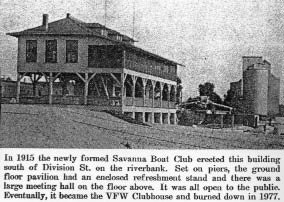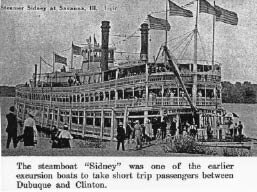
Discover rewarding casino experiences. 

Please Don't Quote Me As the second decade of the twentieth century had begun, Savanna was well established as a community, a far cry from the woodcutters post of 1828 and its “pre-history” as the “Council Bluffs” of the Upper Mississippi when the native American used the site. Their council lodge served as first shelter of the white man. In 1910-11 brick and frame mansions of the well-to-do filled that space. |
The few people that had come in 1828 and the next few following years cut wood and trapped and hunted and searched for lead along the rocky bluffs. Steam boats began to stop regularly for the wood fuel to fire their boilers and hardly a thought was given to become a town until in 1836 Luther Bowen, a shrewd businessman had a survey made and town platted. Despite its busy wood stop, no large industry or manufacturer made its base at the savanna except, if you will, Medard Dupuis who had immense sawmills at the river’s edge to dimension the timbers cut in surrounding lands and islands or, more to the point, bought hundreds of log rafts floated down river from the Wisconsin pineries for his lumber, shingle and lath business. Even at mid-19th century he dominated the sawmill industry though there were others in the region including portable ones that were taken by lots of sweat to the islands or inaccessible places. It was estimated, for instance, that in 1852 alone, Dupuis turned over twenty-five million board feet of lumber worth twenty to forty thousand dollars annually, a vast sum then. That date, you’ll note, before the railroads had reached Savanna, customers were said to have come from far distances like Rockford or Freeport to buy lumber at the mills there. In 1853 and for a couple of years, Dupuis had a lumberyard at Freeport, too. As you see, that business prospered so that Medard Dupuis built an impressive mansion at river’s edge, 1121 N. Main, on the very site that one time wigwams/log cabins graced the scene of early settlement. Other steam mills prevailed such as a flouring mill and a powder mill (See PDQ Me - 8/14/85) but which didn’t last as long as they could have but succumbed to competition.
Naturally, numbers of men were engaged in commercial fishing at the turn-of-the-century using seines and various types of nets to snare fish and water creatures for a distant market where they were shipped as rails extended east and westward. Peddlers hawked them in surrounding neighborhoods. A large wagon shop with several dozen mechanics was of some pretension in the town but in 1873 it burned and was never to achieve its standing after that. A certain status was thought to be achieved if a town had a bank and a newspaper. It was progress assured if those continued through the years. Newspapers, however, were notable for going in and out of business, printing in short periods not for lack of readers but usually for lack of capital! From the early day Savanna had a bank, one organized by six or seven of the county’s well-to-do gentlemen and which private concern was first called the Savanna State Bank but became the First National by 1894, meanwhile in 1892 the Commercial State Bank organized and with the other institution also had a savings department! A Homestead Loan Association formed in 1886 and within ten years became the Savanna Savings Building and Loan Association, the only one ot its kind in the county. Yes, the old woodcutters fueling stop had achieved a status unthought of a hundred years before. For its size, reference states, it had not drawn manufactories as it might have but it supported newspapers from the early day. In 1854 the “Savanna Register” appeared but lasted only a few months. The “Savanna Times” was then issued, it being printed in Shannon at the “Shannon Gazette” for several months until equipment was moved to the river town in 1875. It and subsequent county newspapers were Republican in leanings except for the “Savanna Journal,” first printed in 1895 which was Democrat in nature. As the years had passed into the early years of twentieth century, Savanna was sporting all the trappings of a substantial community. It had the usual amenities, utilities and refinements of most towns its size such as a telephone exchange. Frank Zinnerl was the “Bell” of Carroll county having established or bought an exchange in every town in the county and the 1890’s the Independent Telephone Co. had been organized by Zinnerl in 1892 who within a short time increased its stock holdings and by 1910 there were thought to be about 3,000 patrons thorughout the county, most being in the west sections. Zinnerl’s forward-looking character was seen in his enthusiasm for the automobile which he promoted energetically, anytime, anywhere. He lived in Savanna where the newspaper reported he was the first to build a separate “automobile apartment” for his car; a garage, no less! Two artesian wells were the basis of the city’s water system. The city council had recently been planning a sewerage system throughout the town, a great convenience. The electric light plant was a private enterprise. All these were from a responsible and responsive public awareness. A public school had been built in 1870, a high school ($40,000) in 1903. The first school teacher, however, Hannah Fuller, had taught in 1836 in the usual make-shift quarters as well as did Dr. Elias Woodruff, the town’s first doctor. People making the future happen. Brick buildings dotted the commercial section replacing the board and canvas shanties that had served so well in the early day. Brick streets, hard brick, paved the main streets while others were madadamized, some even outside the city limits. Several miles of cement sidewallks were replacing wood plank ones. Two breweries had provided jobs for a number of the population but only one had survived for very long. A distillery, too, had been a local business making whiskey and high wines from local wheat and rye. Competition from larger concerns, however, had forced it out of business. If the breweries contributed to the liquor arguments at election time, source does not say but it was an issue for many years. In 1874 Savanna was incorporated as a town under state law and an election for mayor and city council took place. It was reported that the contest was “extremely animated,” it being an “anti-license vs. license” debate. The result was very close with Medard Dupuis narrowly winning the “license” ticket which issue guided many successive elections, “saloons were allowed most years after that,” reference states. And in the second decade of the twentieth century saloons paid $500 annually for a license to sell liquor. There were twenty-one saloons circa 1910. Quoting source it states that, “The saloons carry on such an extensive business that it tends greatly to the demoralization of a considerable number of citizens of the community, neighboring towns and surrounding area.”
That didn’t mean that respectability did not dominate the community. There were seven churches, the Methodists having met from the 1830’s and its first settlers. Andrew Carnegie had funded the public library and a Cemetery Association had formed a burying ground. Patirotic organizations of several sorts had formed clubs and, as well, there were many social groups including a Savanna Boat Club, a “Commodore” presiding and whose members enjoyed the pleasure of sailing and camping also in quaint little cabins on either side of the Mississippi. Fishing, leisure, socialability prevailed and many, perhaps forty of the members had boats with gasoline engines by 1910 that made for “fast-going crafts.” The picture with this article is of the Boat Club’s hall (with caption), built a little after the focus of this article, 1910-11. It was taken from the nice photo album “SAVANNA: Yesterday & Today,” sponsored by the Carroll County Genealogical Society, 1979. With our gratitude. The excursion boat too was but one feature in the long chapter of riverboats to grace the history of the river town, Savanna; freighters, rafters, paddlwheels, steamers to diesel. Such an accent to our county. Next Week—a little more yesterday, Savanna, a hundred years ago.
|





